Unlocking Growth: Mastering Conversion Rate Optimization
By: Navi Kang
Chief Strategy Officer
TL;DR: CRO isn’t a project—it’s a loop. Use these 8 plays to ship wins fast, measure what matters, and compound results over time. Each section includes what to change, how to measure, and where it pays off.
Jump to: A/B Testing • CTAs • Page Speed • Forms • Social Proof • Value Prop • Exit-Intent/Behavior • Mobile • Comparison • FAQs
This isn’t about vague best practices. We’re diving deep into specific tactics you can implement immediately. Learn how to:
- Optimize core website elements: From compelling calls-to-action to streamlined forms, we’ll cover the essentials.
- Leverage behavioral insights: Discover how exit-intent popups and targeted messaging can recapture lost conversions.
- Embrace mobile-first design: Ensure your website delivers a seamless experience across all devices.
- Harness the power of social proof: Build trust and credibility to influence visitor behavior.
- Test and refine your approach: Master A/B testing to continuously improve your results.
Whether you’re a SaaS startup, an eCommerce brand, or a B2B organization, these conversion rate optimization tips will empower you to achieve significant growth. Stop leaving money on the table and start optimizing today.
1. A/B Testing and Multivariate Testing
A/B testing is a cornerstone of conversion rate optimization (CRO). It involves comparing two versions of a webpage, email, or other marketing asset to see which performs better.
Why it matters
Testing replaces opinions with data and compounds wins quarter over quarter.
You show different versions (A and B) to different visitor segments simultaneously and measure which variation drives more conversions.
Multivariate testing takes this further, testing multiple elements at once to understand their combined impact on conversion rates.
Do this
Prioritize ideas by Impact × Confidence × Effort (ICE).
Test one variable at a time; set MDE (Minimum Detectable Effect) is the minimum change in conversion rate you want your A/B test to reliably detect, power, and stop rules in advance.
QA across devices; log learnings in a living playbook.
Measure
- Primary KPI (e.g., trial starts, checkout completion), lift %, runtime to significance.
This allows you to identify winning combinations and optimize your marketing efforts more effectively.
Examples of A/B Testing Success
Below are a few quick examples of companies that have demonstrated the impact of A/B testing:
- HubSpot increased conversions by 21% by simply testing different CTA button colors.
- Going increased their trial conversion rate by 104% by testing different CTA copy.
- TribeTokes increased their conversion rate by 19% by testing product thumbnails for PLP subcategory navigation.
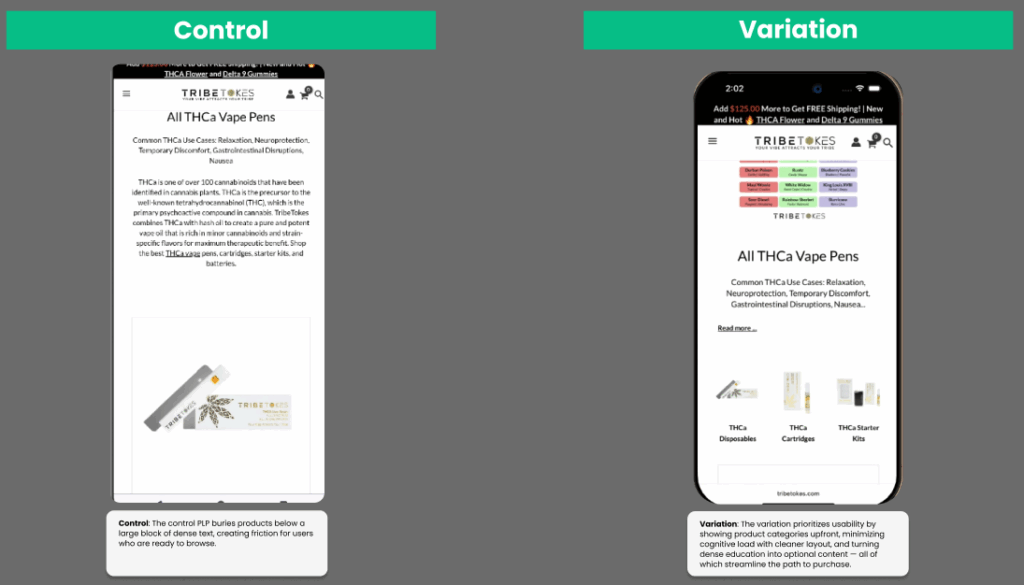
Control: The control PLP buries products below a large block of dense text, creating friction for users who are ready to browse.
Variation: The variation prioritizes usability by showing product categories upfront, minimizing cognitive load with cleaner layout, and turning dense education into optional content — all of which streamline the path to purchase.
Why it worked: The PLP variation worked because it aligned with core eCommerce UX principles: reduce friction, increase clarity, and guide users toward action.
By surfacing product categories above the fold, we minimized cognitive load and allowed users to immediately understand their options without having to scroll or read through dense content.
This created a more intuitive browsing experience, which improved decision-making speed and product discoverability.
Actionable A/B Testing Tips
To maximize the effectiveness of your A/B tests, consider these tips:
- Test one element at a time: This isolates the impact of each change, providing clearer results.
- Ensure adequate sample size: Don’t jump to conclusions prematurely. Gather enough data before making decisions.
- Run tests for full business cycles: Account for weekly or monthly fluctuations in user behavior.
- Focus on high-impact elements: Prioritize headlines, CTAs, and form fields.
- Document everything: Keep detailed records of your tests for future reference.
These examples highlight how even small changes can yield significant improvements in conversion rates.
The A/B Testing Process
The following visual demonstrates Northpeak’s core process of A/B testing, highlighting the essential steps for effective optimization.
The infographic outlines a clear eight-step process:
- Research & Planning
- Ideation & Validation
- Feasibility
- Conceptualization & Build
- Approval & QA
- Validation Testing
- Analysis & Iterate
- Implementation
This cyclical process allows for continuous improvement based on empirical evidence.
When should you use A/B testing? Anytime you need to make data-driven decisions about your website or marketing materials.
From optimizing landing pages and email campaigns to improving user experience and increasing sales, A/B testing offers a proven path to higher conversion rates.
Tools like Optimizely and VWO, popularized by CRO pioneers like Bryan Eisenberg, have made A/B testing more accessible than ever.
2. Call-to-Action (CTA) Elements
Call-to-action (CTA) optimization involves strategically designing and positioning action-oriented buttons, links, and messages.
These elements guide visitors toward desired conversions. This includes optimizing button text, colors, size, placement, and surrounding context.
Why it matters
- CTAs guide momentum. Clarity and prominence drive clicks, and clicks drive revenue.
Do this
Use first-person, benefit-led copy (“Start my free trial”).
One primary CTA per view, above the fold, with adequate whitespace.
Add sticky mobile CTAs on PDPs and long pages.

Newfront’s CTA button, “Talk to an Expert,” uses a vibrant magenta pink color and a hover animation to immediately grab attention and guide users toward engaging with a team specialist.
Here are a couple companies that have seen impressive results from optimizing their CTAs:
- ContentVerve increased the CTR for Unbounce by 90% by changing CTA text from “Start your free 30-day trial” to “Start my free 30-day trial.” This simple change personalized the user experience.
- Campaign Monitor improved click-through rates by 127% using personalized CTAs. Tailoring CTAs to individual users can significantly improve engagement.
The goal is to maximize click-through rates and conversions. Effective CTAs create urgency, provide clear value propositions, and remove friction from the conversion process.
Measure
- CTA CTR → next step, assisted conversion rate, heatmap engagement.
These examples highlight how seemingly minor tweaks can yield substantial improvements.
Actionable CTA Optimization Tips
To maximize the effectiveness of your CTAs, consider these tips:
- Use first-person language: Phrases like “Get My Free Trial” create a sense of ownership and encourage clicks.
- Create urgency: Time-sensitive language like dates or “Limited Time Offer” can motivate immediate action.
- Visual prominence: Ensure CTAs stand out visually from other page elements. Use contrasting colors and clear design.
- Strategic placement: Place primary CTAs “above the fold,” so they are immediately visible without scrolling.
- Testing is key: Test different button sizes, shapes, and colors to find what resonates best with your audience.
- White space: Use white space effectively to make CTAs more prominent and draw attention.
Test next
- “Get pricing & timeline” vs “Submit” on B2B forms
- Sticky mobile “Add to cart”
- Free-trial CTA variants
3. Improve Page Loading Speed and Performance
Speed is the first impression. Slow pages kill sessions, rankings, and revenue.
This involves technical optimizations like image compression, code minification, and improved server response times.
It also includes leveraging content delivery networks (CDNs). Fast-loading pages directly impact user experience, search engine rankings, and, ultimately, conversion rates. Users are quick to abandon slow-loading websites.
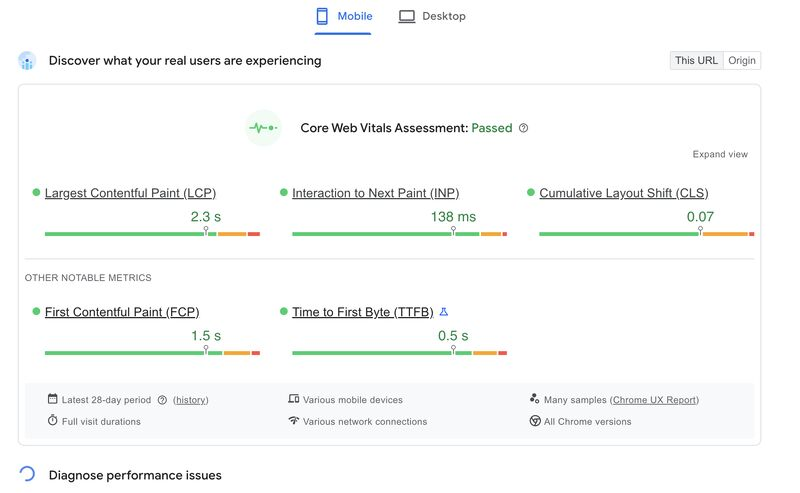
Core Web Vitals are Google’s way of measuring how good a website’s experience is for its users. They track and evaluate three key factors: how fast the page loads, how quickly it reacts when you interact with it, and if content on the page unexpectedly moves around.
Do this
Target TTFB < 200ms, LCP < 2.5s, CLS < 0.1.
Convert images to WebP/AVIF; lazy-load below the fold.
Minify/defers JS; reduce third-party bloat; serve via CDN.
Examples of Page Speed Optimization Success
Several companies have seen significant improvements after prioritizing page speed:
- Walmart found that for every 1-second improvement in page load time, conversions increased by 2%.
- Amazon calculated that a 100ms delay in page load time costs 1% in sales.
- Pinterest reduced page load times by 40% and saw a 15% increase in search engine traffic.
These examples demonstrate the strong correlation between page speed and business outcomes.

Actionable Page Speed Optimization Tips
To improve your website’s loading speed, consider the following tips:
- Improve LCP 5-10%: Add
fetchpriority="high"to your hero or main product image to make it load first—instantly improving LCP and speeding up your page by 5–10%. - Aim for page load times under 3 seconds: This is a generally accepted benchmark for a good user experience.
- Optimize images: Use WebP format for better compression and quality.
- Minimize HTTP requests: Reduce the number of elements your page needs to load.
- Use browser caching effectively: Store static assets locally to speed up repeat visits.
- Implement lazy loading: Load below-the-fold content only when needed.
- Regular performance audits: Use tools like Google’s PageSpeed Insights and GTmetrix to identify areas for improvement.
Ship next
- Compress hero images
- Remove unused JS
- Preload key fonts
- Audit apps/plugins monthly
When to Prioritize Page Speed
Page speed optimization is crucial for any business with an online presence. Prioritize it especially if:
- Your bounce rate is high: Users might be leaving due to slow loading times.
- Your mobile conversion rate is low: Mobile users are particularly sensitive to page speed.
- Your website relies heavily on images or videos: These elements can significantly impact load times.
Implementing these page speed optimization techniques, popularized by experts like Steve Souders and tools like Google PageSpeed Insights, is a crucial aspect of conversion rate optimization.
It’s an investment that pays off in improved user experience, higher search rankings, and increased conversions.
4. Simplify Forms and Reduce Friction
Form optimization is a critical aspect of conversion rate optimization (CRO). It involves streamlining forms to reduce friction and increase completion rates.
Why it matters
Every extra field is a reason to bail.
This means minimizing required fields, using smart form design, implementing progressive disclosure, and removing unnecessary steps in the conversion process.
The goal is to collect essential information while making the process as seamless as possible for users.
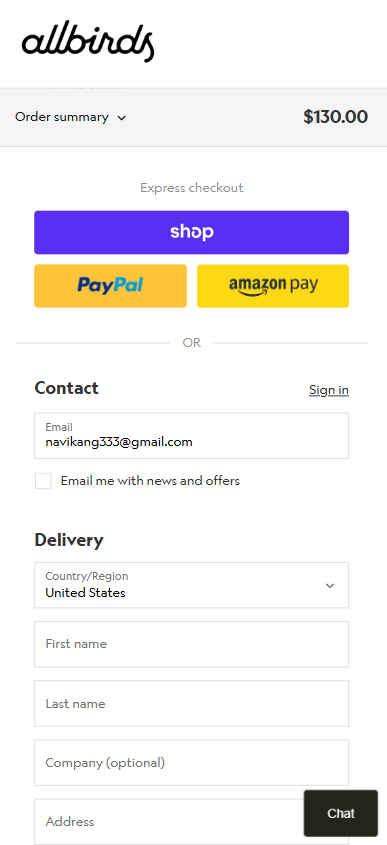
Allbirds utilizes Shopify’s one-page checkout solution.
To optimize your forms for higher conversion rates, consider these practical tips:
- Only ask for essential information: Every additional field increases the likelihood of abandonment. Collect only the data absolutely necessary for the conversion.
- Use single-column layouts: These are easier to follow and complete compared to multi-column forms, improving user experience.
- Implement inline form validation: Providing real-time feedback helps users correct errors immediately, reducing frustration.
- Group related fields logically: This improves form flow and makes the process more intuitive for users.
- Use progress indicators for multi-step forms: This helps users understand their progress and encourages completion.
- Make optional fields clearly marked: This gives users control over the information they share and reduces perceived effort.
Measure
- Form completion rate, time to complete, field-level drop-off
A well-optimized form can significantly improve conversion rates and contribute to business growth.
Examples of Form Optimization Success
Several companies have seen dramatic improvements by simplifying their forms:
- Expedia increased conversions by removing a single field – “company name” – from their booking form. This seemingly minor change demonstrated the impact of reducing friction.
- Marketo improved conversion rates by 10% by reducing form fields from 9 to 5, showcasing the effectiveness of concise forms.
- ImageWorks saw a 120% increase in conversions after reducing form fields from 11 to just 4. This highlights the potential for substantial gains through form optimization.
These examples illustrate how simplifying forms can lead to significant improvements in conversion rates, even with seemingly small changes.
When to Simplify Your Forms
When should you focus on form optimization? Anytime you’re using forms to collect user data, whether for lead generation, purchases, or account creation. Form optimization is particularly important for:
- E-commerce checkout pages: Streamlined forms can significantly reduce cart abandonment.
- Lead generation forms: Shorter forms can lead to higher conversion rates and more qualified leads. However, this is something that should be tested as pre-engagement strategies do work on increasing form completion rates.
- Account registration forms: Simplifying the signup process can encourage user engagement.
Implementing these form optimization techniques can have a direct impact on your bottom line by improving conversion rates and driving business growth.
Why it matters
People follow people. Proof reduces perceived risk at the moment of decision.
Trust signals, like security badges and certifications, further enhance this effect by assuring visitors of your website’s safety and legitimacy.
By incorporating these elements, you tap into the psychological principle of social influence, encouraging visitors to follow the lead of others.
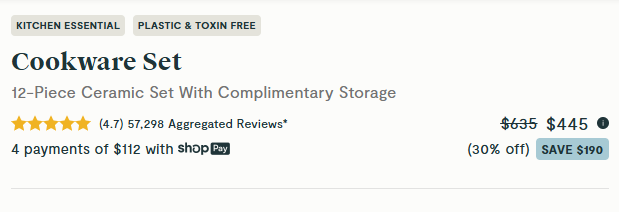
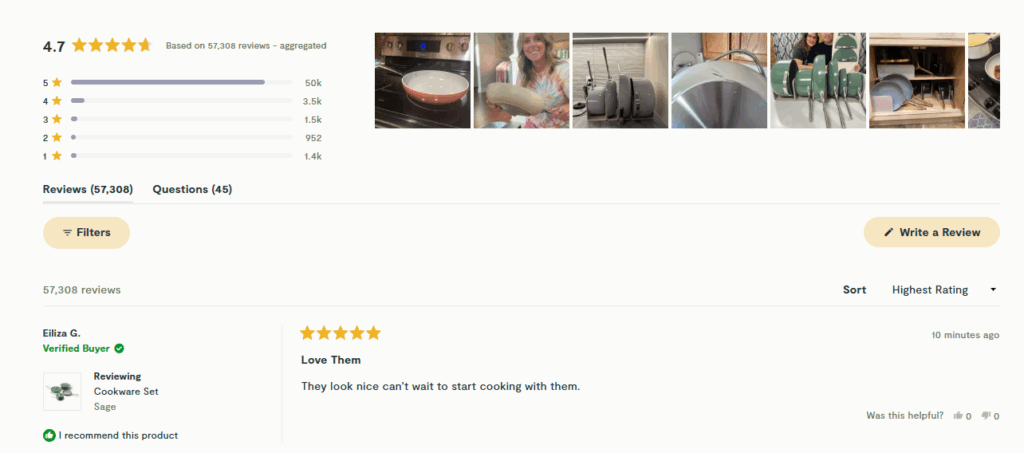
Caraway users star ratings and “57,298” reviews along with testimonials on its PDPs to showcase the success of its product to new users.
Examples of Social Proof Success
Several companies effectively utilize social proof and trust signals:
- Airbnb: Uses host and guest reviews extensively to build trust and encourage bookings.
- Shopify: Shows “Join 1,000,000+ businesses” to demonstrate popularity and social validation.
- Caraway: Displays a 4.8 rating from over 100,000 customers, reinforcing their credibility.
These examples highlight the power of social proof in driving conversions across various industries.
Actionable Social Proof Tips
Maximize the effectiveness of your social proof strategy with these tips:
- Add ratings and review counts near CTAs: Build trust near the conversion point.
- Use specific, detailed testimonials: Avoid generic praise. Focus on tangible benefits and results.
- Include photos and names for authenticity: This adds credibility to testimonials and makes them more relatable.
- Display trust badges near conversion points: Reinforce security and build confidence at the moment of decision.
- Show real-time user activity when possible: This creates a sense of dynamism and social validation.
- Highlight testimonials from similar customers: Target specific demographics with relevant social proof.
- Use video testimonials for higher impact: Video testimonials can be more engaging and persuasive.
Implementing Social Proof and Trust Signals
When should you use social proof? Anytime you want to increase trust and credibility, particularly on landing pages, product pages, and checkout flows.
Test next
- “Why customers choose us” row
- “As seen in” PR strip
- Secure checkout badges with copy: “30-day happiness guarantee”
Consider the specific needs of your target audience and tailor your social proof accordingly. For B2B companies, showcasing client logos and case studies can be highly effective.
For eCommerce businesses, customer reviews and ratings are crucial. By leveraging social proof and trust signals strategically, you can significantly influence visitor behavior and boost your conversion rates.
6. Create Compelling and Clear Value Propositions
Value proposition optimization involves crafting and presenting clear, compelling statements that communicate the unique benefits of your product or service.
Why it matters
If visitors can’t tell why you’re better—fast—they leave.
A strong value proposition answers why a customer should choose you over competitors, addressing their problems and highlighting the benefits they’ll receive. This should be prominently displayed and consistently communicated across all conversion points.
Optimizing your value proposition is a crucial aspect of conversion rate optimization, directly influencing a customer’s decision to engage and convert.
Examples of Successful Value Propositions
Several companies have effectively leveraged compelling value propositions:
- Uber: “Get there. Your day belongs to you” focuses on time-saving convenience.
- Dollar Shave Club: “Great razors for a few bucks a month” combines quality and affordability.
- Zoom: “Video communications for the modern workplace” highlights reliability and ease of use.
- Slack: “Where work happens” emphasizes productivity and collaboration.
These examples demonstrate how a concise and targeted value proposition can resonate with the target audience.
Actionable Value Proposition Tips
To create a high-converting value proposition, consider the following tips:
- Focus on benefits, not features: Explain how your product improves customers’ lives, not just its technical specifications.
- Use customer language: Speak directly to your target audience using their terminology and addressing their pain points.
- Be specific and measurable: Quantify your benefits whenever possible, using data and statistics to support your claims.
- Test different variations: A/B test different value propositions to identify what resonates most with your target audience.
- Align with customer research: Ensure your value proposition reflects the actual needs and desires of your customers.
- Keep it simple and easy to understand: Avoid jargon and complex language. Clarity is key.
When to Optimize Your Value Proposition
You should continually evaluate and refine your value proposition, especially when:
- Launching a new product or service
- Entering a new market
- Experiencing declining conversion rates
- Receiving negative customer feedback
- Conducting competitor analysis
Measure
- Hero engagement, scroll depth, CTA CTR, demo/trial starts/purchases
Test next
- Rewrite hero to “Get [Outcome] in [Timeframe], not [Pain]”
- Add a “Why we’re different” section with 3 proof points
7. Implement Exit-Intent and Behavioral Targeting
Exit-intent and behavioral targeting leverages visitor behavior data to create personalized experiences and deliver targeted interventions.
Why it matters
Smart, respectful interrupts can recover abandoning users and grow lists profitably.
Exit-intent technology detects when a user is about to leave a webpage and presents a targeted offer or message.
Behavioral targeting analyzes user actions like time on page, scroll depth, and other metrics to deliver relevant content and offers at optimal moments, ultimately recovering potentially lost conversions.

Blume converts 5% of visitors using a 20% discount for new users.
Several businesses have seen substantial gains using these techniques:
- Sumo grew their email list by 50% using exit-intent popups.
- OptinMonster helps businesses recover an average of 15% of abandoning visitors.
- Neil Patel’s blog utilizes exit-intent to offer valuable content upgrades.
- Ecommerce sites frequently employ cart abandonment triggers to recover lost sales.
These cases illustrate how targeting specific behaviors can significantly impact key metrics.
Actionable Exit-Intent and Behavioral Targeting Tips
To maximize your results, consider these practical tips:
- Offer genuine value: Exit-intent popups should provide compelling incentives, not annoy users.
- Tailor triggers: Implement different triggers for different page types.
- Limit frequency: Avoid overwhelming visitors with excessive popups.
- Test timing and sensitivity: Optimize trigger sensitivity to avoid premature or delayed popups.
- Personalize offers: Base offers on visitor behavior for increased relevance.
- Easy dismiss options: Always provide a clear and easy way for users to close the popup.
Implementing Exit-Intent and Behavioral Targeting
Understanding your customer is key to effective implementation. When should you use exit-intent and behavioral targeting?
Consider implementing these techniques if you are experiencing high bounce rates, cart abandonment, or low conversion rates. By understanding user behavior and intervening strategically, you can transform potentially lost opportunities into valuable conversions.
8. Mobile Optimization and Responsive Design
It encompasses mobile-specific user experience considerations, touch-friendly interfaces, simplified navigation, and mobile-optimized checkout processes.
With mobile traffic frequently surpassing desktop traffic, mobile conversion optimization is crucial for overall conversion rate success. Ignoring mobile users is essentially ignoring a significant portion of your potential customer base.
Actionable Mobile Optimization Tips
To enhance your mobile conversion rates, consider these practical tips:
- Design for mobile-first, then scale up: This approach ensures a seamless mobile experience from the outset.
- Use larger buttons and touch targets (44px minimum): Make it easy for users to interact with your site on smaller screens.
- Simplify forms for mobile input: Reduce the number of fields and optimize for mobile keyboards.
- Optimize images for mobile bandwidth: Faster loading times improve user experience and conversions.
- Test on actual devices, not just simulators: Real-world testing identifies unforeseen issues.
- Consider mobile-specific payment options: Streamline the checkout process for mobile users.
When to Use Mobile Optimization
Mobile optimization is not a one-time fix but an ongoing process. Any business with a website or online presence should prioritize mobile optimization.
With the ever-increasing dominance of mobile usage, neglecting this aspect can significantly hinder your conversion rates and overall business growth. Learn more about Mobile Optimization and Responsive Design.
Continuously analyze your mobile traffic and user behavior to identify areas for improvement and ensure your website remains optimized for the best possible mobile experience.
Comparing 8 Key Conversion Rate Optimization Strategies
| Strategy | Use When… | Complexity | Resources | Expected Outcome |
|---|---|---|---|---|
| A/B & MVT | You have traffic and competing ideas | Med–High | Med | Reliable, compounding wins |
| CTAs | Click-through is weak | Low–Med | Low | Immediate CTR & CVR lift |
| Page Speed | Bounce is high, mobile is slow | High | High | Better UX, SEO, revenue |
| Forms | Lead/checkout abandon is high | Med | Med | Higher completion & quality |
| Social Proof | Trust is the blocker | Low–Med | Low–Med | Reduced hesitation, higher CVR |
| Value Prop | Message isn’t landing | Med | Med | Better fit, deeper engagement |
| Exit/Behavior | High exit, low list growth | Med–High | Med–High | Recovered revenue, LTV |
| Mobile | Mobile CVR trails desktop | Med–High | Med–High | Material mobile CVR gains |
Elevate Your Conversions: Start Optimizing Today
This comprehensive guide has explored eight key conversion rate optimization tips, offering actionable strategies to transform your website into a high-performing lead generation and revenue-driving machine.
From A/B testing and crafting compelling CTAs to optimizing page speed and leveraging social proof, each tactic plays a crucial role in enhancing user experience and driving conversions.
Remember, these strategies are not isolated tactics but interconnected elements that contribute to a holistic CRO approach.
Key Takeaways: Putting Insights into Action
Let’s recap the most impactful takeaways. By focusing on these core principles, you can lay the foundation for sustained conversion growth:
- Prioritize Speed: Website speed directly impacts user experience and bounce rates. Optimizing loading times is paramount for keeping visitors engaged and moving them through the conversion funnel.
- Clear Value Proposition: Articulating a clear and compelling value proposition is crucial. Visitors need to understand the benefits of your product or service instantly to stay engaged.
- Frictionless Experience: Streamline forms, simplify navigation, and optimize the checkout process. Removing any obstacles in the user journey encourages conversions.
- Mobile-First Approach: With the dominance of mobile browsing, optimizing your website for mobile devices is no longer optional – it’s essential for reaching and converting your target audience.
- Data-Driven Decisions: A/B testing and data analysis are crucial for understanding what resonates with your audience and refining your CRO strategy for optimal results.
Continuous Optimization ≠ One-and-Done
CRO works when it’s a loop, not a project. Ship small wins weekly, stack them monthly, and compound results over quarters.
Run the loop:
Measure: Find the bottleneck (speed, CTA, form, PDP, checkout).
Hypothesize: Prioritize impact × confidence × effort (ICE).
Test: A/B test, don’t make assumptions.
Learn & Ship: Keep the winner, log insights, queue the next test.
Targeted > Generic
Your motion dictates your playbook. Aim effort where it pays fastest.
SaaS: Clarify value → reduce time-to-value → pricing & plan clarity → frictionless signup.
eCommerce: PLP/PDP clarity → social proof → merchandising (bundles/Frequently Bought Together) → ruthless checkout simplicity.
B2B: Pain-first messaging → proof (case studies, ROI) → risk-reversal → short, smart forms.
Ready to Lift Your Conversions?
Northpeak is an award-winning CRO and Growth partner. We help top eCommerce, SaaS, and B2B brands craft high-converting website experiences that outperform the competition, boasting an average 30% conversion lift and a 62% win-rate across over 3,000 A/B tests.
Next steps:
Book a 1:1 consult or get a Free Mini-Audit (Northpeak clients typically see a 10x average ROI)
See your top 5 revenue wins and map your first 90-day optimization plan.
FAQs
It depends on product, price point, traffic quality, and intent. As a rough benchmark, many eCommerce sites target 2–3%+ storewide, while high-intent pages (PDPs, pricing, checkout) should be higher. Similarly for SaaS – there isn’t one number. As ballparks: 0.7–2% of visitors request a demo (sitewide), free-trial signups run 3–8% without a credit card and 0.5–2.5% with a credit card. More important than any average is to baseline by channel/page type/device and improve it week over week.
Run at least 14 days and until you reach your pre-set sample size and statistical power (usually 80–90%). Cover at least one full business cycle (include a weekend if that matters). Don’t “peek” early—use a calculator to check statistical significance. Popular tools include:
Baseline: note your current conversion rate on the target page.
Pick an MDE: the smallest lift worth acting on (+5%).
Set power/alpha: power 80–90%, alpha 5%.
Calculate sample size: use a calculator; adjust for variant count and traffic split.
Reality check: if traffic is low, batch bigger changes or test upstream (higher-traffic pages).
While there are many CRO tools that can easily add up to thousands of dollars per month, here are some free tools to help you get started:
Analytics: Google Analytics
Behavior: Microsoft Clarity
Testing: VWO
Speed: Google PageSpeed Insights

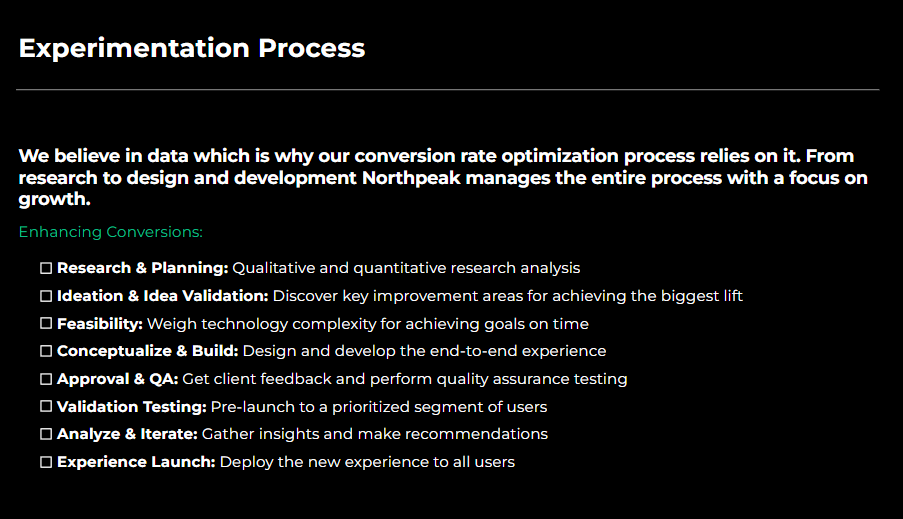

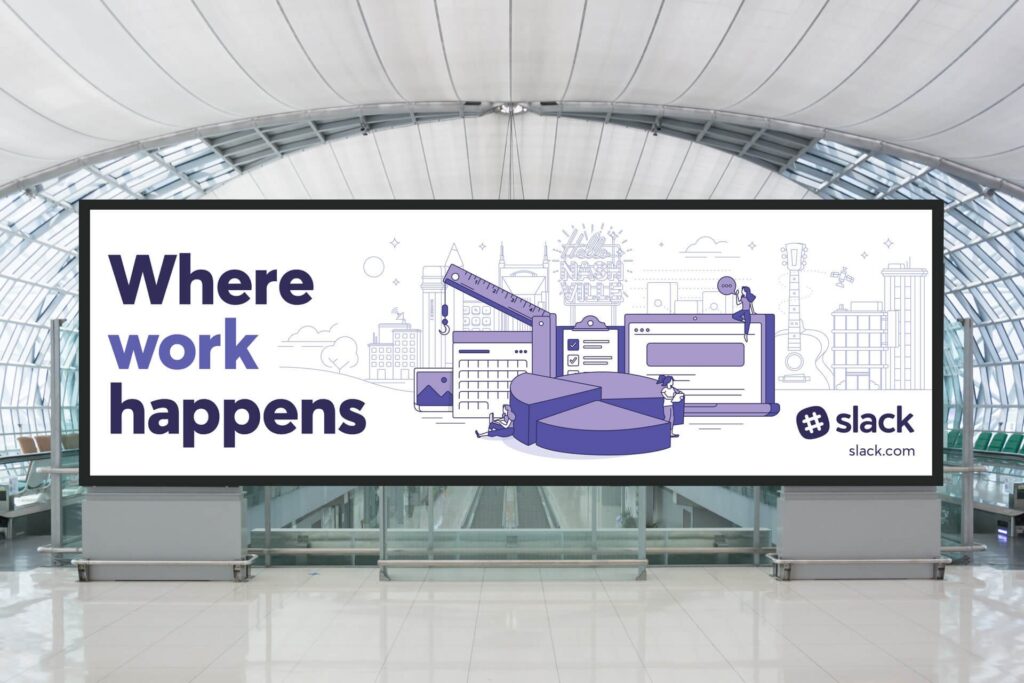







5. Leverage Social Proof and Trust Signals